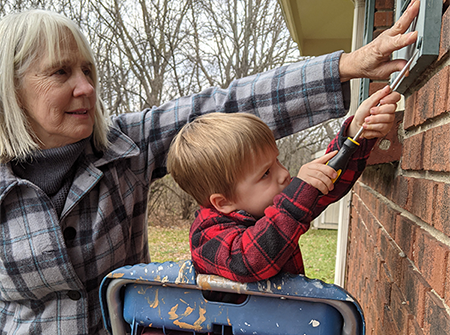Primary Level
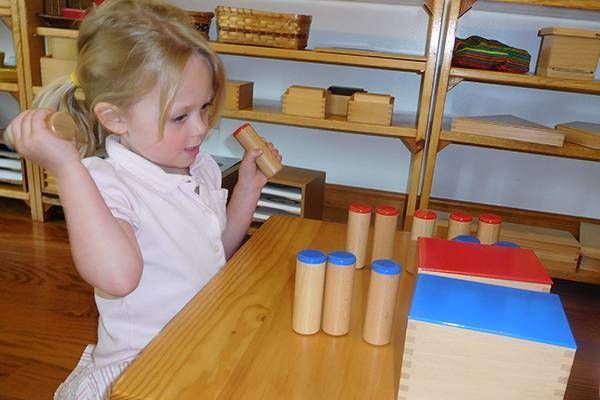
What Do Children Do with Montessori’s Sensorial Materials? Imagine you are watching a four-year-old boy carry a wooden box with a red lid to a table. Then, he goes back to the shelf of Sensorial Materials and brings over a matching box—this one with a blue lid. (These are called the Sound Cylinders. Each is filled with about one ounce of grains of sand ranging from very fine to coarse, in subtle gradations so that each cylinder makes slightly different sounds when shaken). The boy removes each lid and slides them underneath each corresponding box. He carefully lifts eight wooden cylinders out of the boxes and lines them up in front of each box: the ones with blue tops in front of the blue-lidded box and the ones with reds tops in front of the red-lidded box. He mixes these identical red and blue topped cylinders around, and then lines them up again by color in two columns. He is now organized and ready to begin the game. He lifts a red-topped cylinder with his left hand and shakes it by his left ear. He then lifts the first blue-topped cylinder with his right hand and shakes it by his right ear; back and forth, he compares the sounds. He decides that they do not match, so he places the blue-topped cylinder in the back of the row of “blue cylinders” and moves on to the second blue-topped cylinder. He does this until he finds one that sounds the same and places this pair in a new column. He does this with all the cylinders until he has a double column of matching pairs. He checks them one more time, comparing carefully, his eyes soft as he focuses all his attention on the very faint sounds. When he determines he is correct, he mixes them up, deciding he wants to do it again. After the second time through, he puts the materials back on the shelf and moves on to another activity. This game introduces this young boy to a systematic way to compare qualities and keep the choices already tested in logical order. It gives him an option when he wants to compare other things in life and familiarizes him with an organized way to do math problems or eliminate options when looking for an answer to a “problem” of any kind. Equally important, it helps children to refine their sense of hearing and their capacity for concentration through an entire process. As a bonus, little children think such games are very fun! They love the challenge and the sensorial exploration. What Characteristics Identify Montessori’s Materials? There are certain qualities that Dr. Montessori’s Sensorial Materials share. They each isolate a sense or quality to bring the child’s attention to it. There is only one of each material to eliminate confusion. And by “…removing as far as possible all distracting factors…[this] enables the child to engage in an inner and external analysis that can help him to acquire an orderly mind” (Maria Montessori, The Discovery of The Child). Each sensorial material is: A materialized abstraction Progresses from general to specific From familiar to the unfamiliar Involves physical movement Isolates a difficulty Is limited in certain ways so that it draws in the child’s focus Serves as indirect preparation for something else (learning to read, write, or do arithmetic) Contains an inbuilt control of error Provides a key to the world Has a specified place in a sequence of presentations Arguably the most exciting thing about the Sensorial Materials are the games that the teacher teaches the children to play with them. There are matching games (where we connect two items with identical qualities), grading games (where we put objects or qualities in an order based on gradation of that quality), and language games (where we name, and sometimes label, qualities as we discover them). The games are very important because they help children exercise and further develop their memory-building capacities. When we build memorizing techniques in a game-like fashion, we get better at memorizing information and are better able to hold foundational facts in our minds. Here’s a surprise for you: Montessori children are not more intelligent; they’ve just received many more opportunities to develop their minds than children typically get in other educational settings. The games we play with the Sensorial Materials every day is one of the key ways this happens. What A Wonderful World! The knowledge the children gain through this specialized set of Montessori materials relates directly to their experience of the world around them. Children have a repertoire of categorized information at their fingertips and the language to identify and name their experiences in the world: “This is hot. This is cool. This is cold. This is tepid.” “This feels rough. This feels smooth.” “This is heavy. This one is heavier. This is long, that is longer, this other one is the longest.” “This is sour. This is sweet. This is bitter.” “That is loud. This is louder.” And even more specifically: “This is Poland. This is Mexico. This is Bhutan.” “This is the flag of Iraq.” “This is an obovate leaf. That one is hastate.” “This is a pentagon. That is a hexagon.” “That is lavender. This is fuchsia.” “This musical note is a C. This note is an F.”
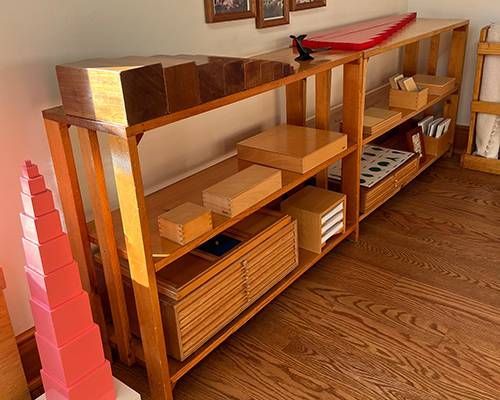
Why Are Montessori’s Sensorial Materials Important for Children? Great question! We all recognize those beautiful wooden prisms and the pink tower of cubes as being Montessori’s distinct materials for children’s development. The glossy red rods and the blocks with rows of tiny wooden knobs are intriguing. They seem to call out to be touched and handled. But there is so much more to this special set of 25 Sensorial Materials than their beauty; they are instrumental to children’s individualized educations, as students and as human beings. The Sensitive Periods There are distinct periods of human development through which every young child passes by the time they are five years old. These sensitive periods make children especially attuned to a particular physical sense, and to concentrate on it almost to the exclusion of all others. This happens for every child but can be hard to recognize if adults are not paying attention to their children’s behaviors or providing opportunities for children to explore these aspects of their surroundings. For a young child, the world is a jumbled mass of impressions. He or she arrives on Earth with no knowledge, but with a gift of five senses—touch, taste, smell, hearing and sight—and the urge to explore through them. To help each child make sense of this world, education must offer a way to organize and label the chaos that they encounter every day. The orderly Sensorial Materials do just this. As a child learns from working with Montessori’s Sensorial Materials in the classroom, he or she goes back out into the world and delights in naming qualities and recognizing forms all around them; it is as if she sees color for the first time now that she knows what it is, what it is called, and where it belongs in the order of things. Imagine what a joy this revelation is for a child! The Sensorial Materials are foundational to Montessori education. Dr. Montessori’s journey as an educator began, in fact, with sensorial materials. Maria Montessori’s first professional task as a physician was to attend to the physical and mental wellbeing of young children in a psychiatric asylum. She learned so much about human development by working with these children with issues ranging from physical disabilities to psychological disturbances. Unfortunately, in the early 1900s in Europe, it was customary to segregate such individuals from society and lock them into a room with nothing to do. Montessori’s heart went out to these children. The first thing she noticed by observing them was the intense need for sensorial stimulation to feed not only their bodies, but their minds. Nature drives us to touch and handle objects from early ages in an effort to understand the world and develop the connections between our bodies and our minds—between movement and thinking. In this way, human beings identify and name the qualities of the world—color, scents, sounds, etc. Everything has a relationship to all else, a place in a set of qualities, and a name we attach to it. Dr. Montessori realized, “The child is by his nature an avid explorer of his surroundings because he has not yet had the times or means of knowing them precisely” ( The Discovery of the Child ). She recognized that we can help children to acquire this knowledge in an organized fashion. As Dr. Montessori experimented systematically in showing children her first materials, she found that they were drawn to them and wanted to repeat their activities until they mastered each one. The children, she realized, were educating themselves through their use of these precise materials. They were serving a fervent need. By combining her discoveries with studies of other doctors’ and scientists’ work, Maria Montessori designed and experimented with sensorial materials that would inform children about the qualities of the real world. To this day, her Sensorial Materials brilliantly support children to explore and learn the language for identifying differentiating qualities of color, temperature, size, weight, length, height, and spatial equalities. They enable children to train and practice their hand-eye coordination, decision making ability, discernment between details, and organization of information. The sensorial materials help children to build their unique, organized minds. Which Ones Are The Sensorial Materials and What Does Each Address? Below is a basic list of Dr. Montessori’s Sensorial Materials and the qualities children explore with them, which you will find in any AMI-accredited Primary classroom for children ages 3 to 6 years old. Form and Dimension Form and dimension are explored in the visual sense with: The Solid Cylinders The Brown Stair The Pink Tower The Red Rods The Knobless Cylinders
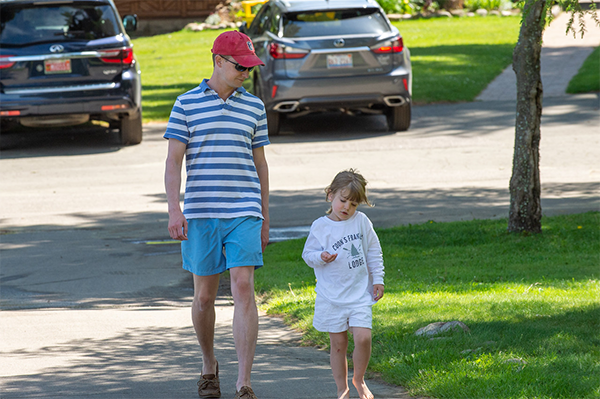
Getting Away With It...Again “Jerry, it’s time to get out of the pool. Time to go now, please.” A father stands at the edge of a hotel pool in summer, clearly exhausted, as his wife walks past him carrying a crying baby girl, a floaty, a diaper bag, and two huge towels. “NO!” The boy in the pool, who looks to be about six years old, screams and makes an exaggerated pout, then disappears under the water before his father can say anything more. I feel terribly sorry for this father, and I swim away, relieved that I don’t have to be in his shoes. Raising children is relentlessly humbling work. Then a second thought comes to me: I can’t help but feel concerned for the little boy getting away with this kind of noncompliant behavior. From his confident air, I am guessing that this is a pattern in their family. In recent years, I’ve noticed that some children, of all ages, seem to be making decisions for their parents and directing their parents. Are children more rude than in the past? More difficult? I don’t think so. But I do think that many of today’s parents hesitate to take charge. Building Pro-Social Behavior The worrisome aspect of allowing children to run the show, in the long run, is that those children who practice pushing their parents around become increasingly unsure of their place in the world. They develop habits that do not ingratiate them to others. The very first cues children receive about social interactions, what is fair and respectful behavior, are those from their parents. These experiences from home set the stage for children’s interactions out in the world with others. Most often, young children who are habitually defiant are searching for boundaries that they desperately crave. The adults in their lives need to provide leadership. They can do so without hesitating or apologizing, but by being loving, fair, and confident. Parents must express confidence when they set the limit and say “No.” They can be sure that by removing a noncompliant child from a situation, they are giving necessary support. The goal at such times is much more far-reaching than the immediate situation at hand. Dr. Montessori wrote, “An individual is disciplined when he is the master of himself and when…he becomes accustomed to a discipline which is not limited to school but extends out into society.” Being able to master ourselves, with the self-control for cooperating with others, is something that adults help children to do over time, from their earliest years onward. What should the guidelines for behavior be? Montessori said, “A child’s liberty should have as its limit the interest of the group to which he belongs.” If the behavior is causing disruption to others—including to you as a parent—then address it promptly. Your aim is to teach your child how to become an integral part of a positive community.
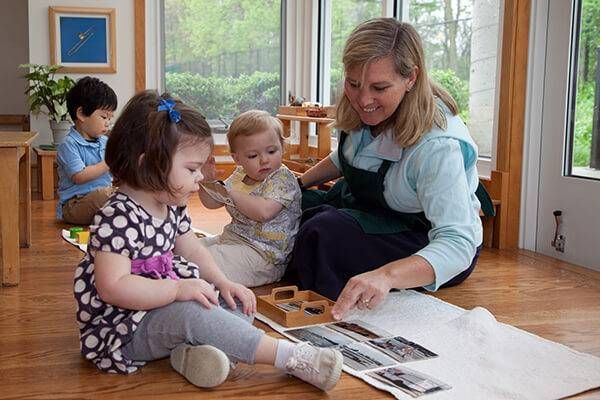
Is it Work? As a parent, you may hear Montessori teachers describe your children’s activities as “work.” Your child may use the word, too, saying, “I love my work,” or, “I did a lot of work today!” But then you may wonder, “Why does my child go skipping in there every day?” and, “Why is my child dying to get back to school after the vacation, and sad when school is canceled?” How can “work” be so much fun? Quite simply, Maria Montessori discovered that working at something that interests them is playful for children, under the right conditions. It must be internally inspired with choice offered for freedom. Montessori found specific ways for children to meet their developmental characteristics and needs through purposeful activities. A kind of joy arises when children can fulfill their natural drive to form their personalities and improve their abilities. In other words, children love to play games that have internal purpose for them. Let's Play a Game!
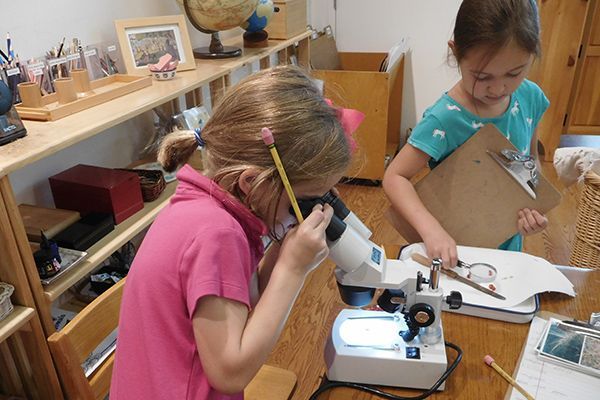
I love finding ways that Montessori’s educational approach inherently addresses human needs. When I look at books espousing the best ways to teach, the best ways to conduct business, or the best ways to be healthy, I usually find that the Montessori approach already incorporates the recommended practices—and always in an integrated, natural way. The Forest Bluff Directors and I are witnessing this once again while reading our latest teacher group discussion book at Forest Bluff, The Innovator’s DNA: Mastering The Five Skills of Disruptive Innovators, by Jeff Dyer, Hal Gregersen, Clayton M. Christensen. In today’s world, the ability to innovate is key to solving problems large and small. I would argue that it has always been important for human survival and progress, but it has become a more urgent need, and now it’s a buzzword for educators. The aforementioned authors explain that to create something new—to innovate—a person needs to associate (connect ideas), network with others (socialize), observe (reflect), question (lead with your curiosity), and experiment (be unafraid to try things and fail). In the Montessori approach, you can see how these practices, or habits, are all actively encouraged and cultivated. Each of these important aspects of innovating are worked into the educational approach seamlessly. Dr. Montessori was simply following what made sense for optimal human development. For one example, Montessori education has captured an essential key to children’s learning: presenting the world in context, from the whole to the parts, with a deliberate, ongoing opportunity for children to associate topics, themes, and details of information. Associating is a crucial skill. Montessori’s approach creates habits in children’s thinking that prepare them for a life of innovative creativity and problem solving by constantly encouraging them to associate.

